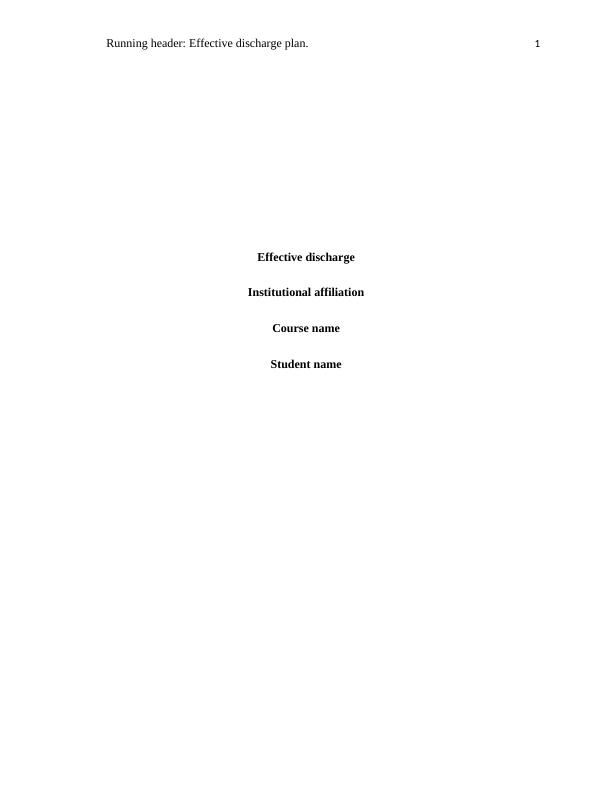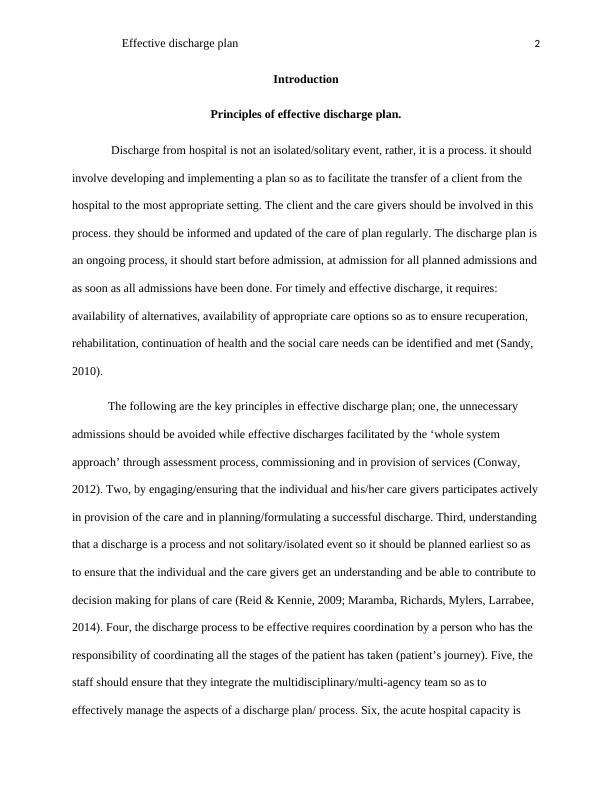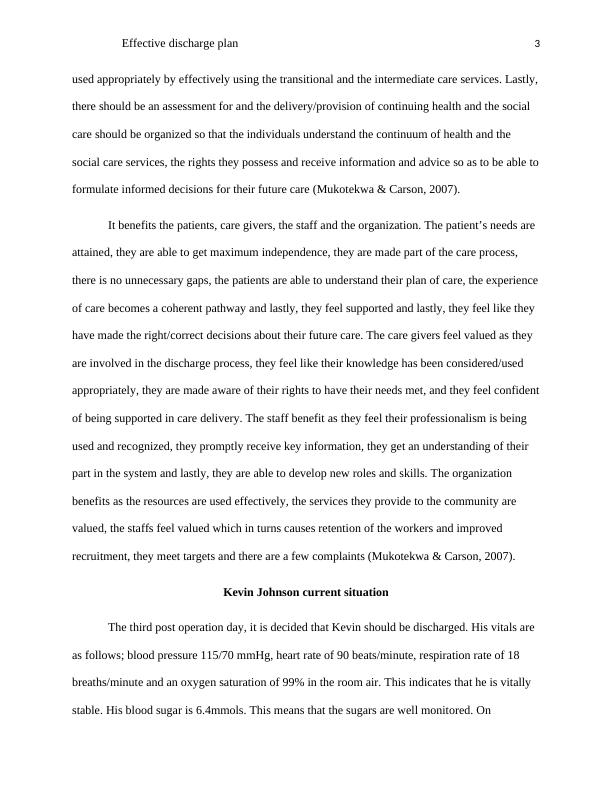Effective Discharge Plan: Principles, Importance, and Case Study
Added on 2023-06-10
11 Pages2986 Words431 Views
Running header: Effective discharge plan. 1
Effective discharge
Institutional affiliation
Course name
Student name
Effective discharge
Institutional affiliation
Course name
Student name

Effective discharge plan 2
Introduction
Principles of effective discharge plan.
Discharge from hospital is not an isolated/solitary event, rather, it is a process. it should
involve developing and implementing a plan so as to facilitate the transfer of a client from the
hospital to the most appropriate setting. The client and the care givers should be involved in this
process. they should be informed and updated of the care of plan regularly. The discharge plan is
an ongoing process, it should start before admission, at admission for all planned admissions and
as soon as all admissions have been done. For timely and effective discharge, it requires:
availability of alternatives, availability of appropriate care options so as to ensure recuperation,
rehabilitation, continuation of health and the social care needs can be identified and met (Sandy,
2010).
The following are the key principles in effective discharge plan; one, the unnecessary
admissions should be avoided while effective discharges facilitated by the ‘whole system
approach’ through assessment process, commissioning and in provision of services (Conway,
2012). Two, by engaging/ensuring that the individual and his/her care givers participates actively
in provision of the care and in planning/formulating a successful discharge. Third, understanding
that a discharge is a process and not solitary/isolated event so it should be planned earliest so as
to ensure that the individual and the care givers get an understanding and be able to contribute to
decision making for plans of care (Reid & Kennie, 2009; Maramba, Richards, Mylers, Larrabee,
2014). Four, the discharge process to be effective requires coordination by a person who has the
responsibility of coordinating all the stages of the patient has taken (patient’s journey). Five, the
staff should ensure that they integrate the multidisciplinary/multi-agency team so as to
effectively manage the aspects of a discharge plan/ process. Six, the acute hospital capacity is
Introduction
Principles of effective discharge plan.
Discharge from hospital is not an isolated/solitary event, rather, it is a process. it should
involve developing and implementing a plan so as to facilitate the transfer of a client from the
hospital to the most appropriate setting. The client and the care givers should be involved in this
process. they should be informed and updated of the care of plan regularly. The discharge plan is
an ongoing process, it should start before admission, at admission for all planned admissions and
as soon as all admissions have been done. For timely and effective discharge, it requires:
availability of alternatives, availability of appropriate care options so as to ensure recuperation,
rehabilitation, continuation of health and the social care needs can be identified and met (Sandy,
2010).
The following are the key principles in effective discharge plan; one, the unnecessary
admissions should be avoided while effective discharges facilitated by the ‘whole system
approach’ through assessment process, commissioning and in provision of services (Conway,
2012). Two, by engaging/ensuring that the individual and his/her care givers participates actively
in provision of the care and in planning/formulating a successful discharge. Third, understanding
that a discharge is a process and not solitary/isolated event so it should be planned earliest so as
to ensure that the individual and the care givers get an understanding and be able to contribute to
decision making for plans of care (Reid & Kennie, 2009; Maramba, Richards, Mylers, Larrabee,
2014). Four, the discharge process to be effective requires coordination by a person who has the
responsibility of coordinating all the stages of the patient has taken (patient’s journey). Five, the
staff should ensure that they integrate the multidisciplinary/multi-agency team so as to
effectively manage the aspects of a discharge plan/ process. Six, the acute hospital capacity is

Effective discharge plan 3
used appropriately by effectively using the transitional and the intermediate care services. Lastly,
there should be an assessment for and the delivery/provision of continuing health and the social
care should be organized so that the individuals understand the continuum of health and the
social care services, the rights they possess and receive information and advice so as to be able to
formulate informed decisions for their future care (Mukotekwa & Carson, 2007).
It benefits the patients, care givers, the staff and the organization. The patient’s needs are
attained, they are able to get maximum independence, they are made part of the care process,
there is no unnecessary gaps, the patients are able to understand their plan of care, the experience
of care becomes a coherent pathway and lastly, they feel supported and lastly, they feel like they
have made the right/correct decisions about their future care. The care givers feel valued as they
are involved in the discharge process, they feel like their knowledge has been considered/used
appropriately, they are made aware of their rights to have their needs met, and they feel confident
of being supported in care delivery. The staff benefit as they feel their professionalism is being
used and recognized, they promptly receive key information, they get an understanding of their
part in the system and lastly, they are able to develop new roles and skills. The organization
benefits as the resources are used effectively, the services they provide to the community are
valued, the staffs feel valued which in turns causes retention of the workers and improved
recruitment, they meet targets and there are a few complaints (Mukotekwa & Carson, 2007).
Kevin Johnson current situation
The third post operation day, it is decided that Kevin should be discharged. His vitals are
as follows; blood pressure 115/70 mmHg, heart rate of 90 beats/minute, respiration rate of 18
breaths/minute and an oxygen saturation of 99% in the room air. This indicates that he is vitally
stable. His blood sugar is 6.4mmols. This means that the sugars are well monitored. On
used appropriately by effectively using the transitional and the intermediate care services. Lastly,
there should be an assessment for and the delivery/provision of continuing health and the social
care should be organized so that the individuals understand the continuum of health and the
social care services, the rights they possess and receive information and advice so as to be able to
formulate informed decisions for their future care (Mukotekwa & Carson, 2007).
It benefits the patients, care givers, the staff and the organization. The patient’s needs are
attained, they are able to get maximum independence, they are made part of the care process,
there is no unnecessary gaps, the patients are able to understand their plan of care, the experience
of care becomes a coherent pathway and lastly, they feel supported and lastly, they feel like they
have made the right/correct decisions about their future care. The care givers feel valued as they
are involved in the discharge process, they feel like their knowledge has been considered/used
appropriately, they are made aware of their rights to have their needs met, and they feel confident
of being supported in care delivery. The staff benefit as they feel their professionalism is being
used and recognized, they promptly receive key information, they get an understanding of their
part in the system and lastly, they are able to develop new roles and skills. The organization
benefits as the resources are used effectively, the services they provide to the community are
valued, the staffs feel valued which in turns causes retention of the workers and improved
recruitment, they meet targets and there are a few complaints (Mukotekwa & Carson, 2007).
Kevin Johnson current situation
The third post operation day, it is decided that Kevin should be discharged. His vitals are
as follows; blood pressure 115/70 mmHg, heart rate of 90 beats/minute, respiration rate of 18
breaths/minute and an oxygen saturation of 99% in the room air. This indicates that he is vitally
stable. His blood sugar is 6.4mmols. This means that the sugars are well monitored. On

Effective discharge plan 4
neurovascular observation, it is observed that the left leg is pink, warm to touch, he can wiggle
the toes and he has sensation below and above the knee. The capillary refill of the toe is normal.
The patient is also able to mobilize himself using crutches and on the activities of daily living, he
showers with minimal assistance.
The key aspects to be focused on.
This paper will focus on effective discharge planning, its key principles, and its
importance aspects in hospital avoidance. Secondly, a brief case study of Kevin Johnson, the key
aspects of effective discharge plan that relates to him, and critically analyzing it. Thirdly, use the
nursing process to discuss the activities of daily living that emerges or are relevant to the client
Kevin during discharge. Fourthly, identify the multidisciplinary team that a nurse would include
in his post discharge care stating the rationale. Lastly, a conclusion that will summarize the
discussion above.
Kevin Johnson case study part 2
Kevin is a fifteen years old young man from the indigenous community, sustained
multiple injuries which resulted from a trail bike accident. During transportation to the hospitals,
his blood pressure was 130/80mmhg, heart rate 110 beats/minute, 22 breaths/minute, saturation
of oxygen 98% on oxygen via a mask, Glasco Comma Scale (GCS) of 13, both limps were pink
although the left limb was cold on touch and was numb. On arrival to the emergency department
the blood pressure was 135/80mmHg, respiration rate 22breaths/minute, heart rate
120beat/minute, GCS 14, the left leg was warm on touch and there was sensation above and
below the injury. The plan of care for Kevin is manipulation of the left leg under anesthesia as he
sustained left tibia fracture and surgical washout or/and debridement or/and minus surgical
neurovascular observation, it is observed that the left leg is pink, warm to touch, he can wiggle
the toes and he has sensation below and above the knee. The capillary refill of the toe is normal.
The patient is also able to mobilize himself using crutches and on the activities of daily living, he
showers with minimal assistance.
The key aspects to be focused on.
This paper will focus on effective discharge planning, its key principles, and its
importance aspects in hospital avoidance. Secondly, a brief case study of Kevin Johnson, the key
aspects of effective discharge plan that relates to him, and critically analyzing it. Thirdly, use the
nursing process to discuss the activities of daily living that emerges or are relevant to the client
Kevin during discharge. Fourthly, identify the multidisciplinary team that a nurse would include
in his post discharge care stating the rationale. Lastly, a conclusion that will summarize the
discussion above.
Kevin Johnson case study part 2
Kevin is a fifteen years old young man from the indigenous community, sustained
multiple injuries which resulted from a trail bike accident. During transportation to the hospitals,
his blood pressure was 130/80mmhg, heart rate 110 beats/minute, 22 breaths/minute, saturation
of oxygen 98% on oxygen via a mask, Glasco Comma Scale (GCS) of 13, both limps were pink
although the left limb was cold on touch and was numb. On arrival to the emergency department
the blood pressure was 135/80mmHg, respiration rate 22breaths/minute, heart rate
120beat/minute, GCS 14, the left leg was warm on touch and there was sensation above and
below the injury. The plan of care for Kevin is manipulation of the left leg under anesthesia as he
sustained left tibia fracture and surgical washout or/and debridement or/and minus surgical

End of preview
Want to access all the pages? Upload your documents or become a member.
Related Documents
Effects of Ineffective Discharge Planning in Hospitalslg...
|12
|781
|329
Wound Care Management NURS2007lg...
|10
|2422
|52
Effects of Ineffective Discharge Planninglg...
|6
|1073
|467
Roemer Model of Healthcare Systemlg...
|5
|1119
|50
Effects of Ineffective Discharge Planninglg...
|5
|792
|338
Essay on Transition of Care for Patient in Conjunctionlg...
|6
|1490
|265
